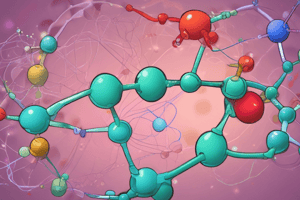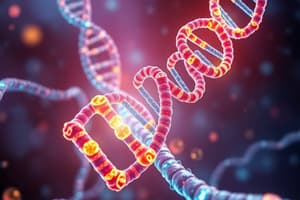Podcast
Questions and Answers
What is the direction of the sugar-phosphate backbone in a nucleic acid?
What is the direction of the sugar-phosphate backbone in a nucleic acid?
- 5' → 3' direction (correct)
- It has no direction
- 3' → 5' direction
- Randomly oriented
What type of bond forms between nucleotides during polymerization?
What type of bond forms between nucleotides during polymerization?
- Hydrogen bond
- Phosphodiester bond (correct)
- Covalent bond
- Ion bond
Which of the following is a characteristic of a nucleic acid strand?
Which of the following is a characteristic of a nucleic acid strand?
- It has a triple-stranded structure
- It has no sugar-phosphate backbone
- It has a directional sugar-phosphate backbone (correct)
- It has a double-stranded structure
What is the result of phosphodiester linkages joining ribonucleotides together?
What is the result of phosphodiester linkages joining ribonucleotides together?
How are the primary structures of DNA and RNA typically written?
How are the primary structures of DNA and RNA typically written?
What is the function of condensation reactions in nucleic acid synthesis?
What is the function of condensation reactions in nucleic acid synthesis?
What is the role of enzymes in nucleic acid polymerization?
What is the role of enzymes in nucleic acid polymerization?
What is the nature of the sugar-phosphate backbone in DNA?
What is the nature of the sugar-phosphate backbone in DNA?
What is the significance of the equal number of purines and pyrimidines in DNA?
What is the significance of the equal number of purines and pyrimidines in DNA?
What technique was used to measure the distances between atoms in DNA?
What technique was used to measure the distances between atoms in DNA?
What is the role of hydrophobic interactions in DNA?
What is the role of hydrophobic interactions in DNA?
What is the term for the sugar-phosphate backbone strands in DNA?
What is the term for the sugar-phosphate backbone strands in DNA?
What is the primary function of DNA as a molecule?
What is the primary function of DNA as a molecule?
What is the result of complementary base pairing during DNA replication?
What is the result of complementary base pairing during DNA replication?
What is the difference between the sugar molecules found in DNA and RNA?
What is the difference between the sugar molecules found in DNA and RNA?
What is the role of phosphodiester linkages during DNA replication?
What is the role of phosphodiester linkages during DNA replication?
What is unique about the 2′ group on the ribose molecule in RNA?
What is unique about the 2′ group on the ribose molecule in RNA?
What is the primary structure of RNA?
What is the primary structure of RNA?
Flashcards are hidden until you start studying
Study Notes
Nucleotide Structure
- A deoxyribonucleotide consists of a 5-carbon sugar (deoxyribose), a phosphate group, and a nitrogenous base.
- The sugar molecule has a 5' carbon, a 1' carbon, a 4' carbon, a 3' carbon, and a 2' hydroxyl group.
Nucleic Acid Polymerization
- Nucleic acids polymerize via condensation reactions, forming phosphodiester linkages between nucleotides.
- Phosphodiester linkages occur between the phosphate group on the 5' carbon of one nucleotide and the hydroxyl group on the 3' carbon of another nucleotide.
- The polymer produced is RNA.
Directionality of Nucleic Acids
- Phosphodiester linkages form a sugar-phosphate backbone that is directional (5' → 3' direction).
- One end of the backbone has an unlinked 5' phosphate group, and the other end has an unlinked 3' hydroxyl group.
- The primary structure of DNA is written by listing the sequence of bases using single-letter abbreviations.
Energy Requirements for Polymerization
- Nucleic acid polymerization requires an energy source, which is provided by adding two additional phosphate groups to create nucleoside triphosphates (activated nucleotides).
- Energy is released when activated nucleotides polymerize, making the reaction spontaneous.
DNA Secondary Structure
- Early data suggested that DNA has a double helix structure, with antiparallel sugar-phosphate backbones and bases attached to sugars forming ladder rungs.
- Hydrophobic interactions (stacking) cause double-stranded DNA to twist into a helix, stabilized by van der Waals interactions.
- DNA has two different-sized grooves: a major groove and a minor groove.
DNA Replication
- DNA replication has three steps: separation of strands, formation of hydrogen bonds between free deoxyribonucleotides and complementary bases, and formation of phosphodiester linkages to create a new strand.
- Complementary base pairing allows each strand to be copied exactly, producing two identical daughter molecules.
RNA Structure and Function
- The primary structure of RNA differs from DNA: RNA contains ribose instead of deoxyribose, uracil instead of thymine, and has a more reactive 2' group on ribose.
- RNA is less stable than DNA due to the 2' group on ribose.
Studying That Suits You
Use AI to generate personalized quizzes and flashcards to suit your learning preferences.




